Menus
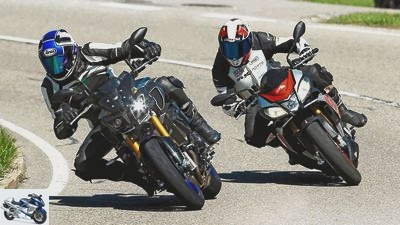
www.factstudio.de
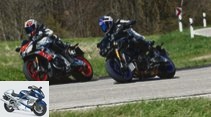
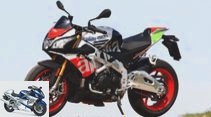
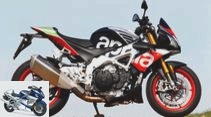
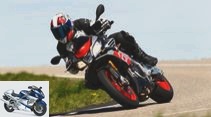
17th photos
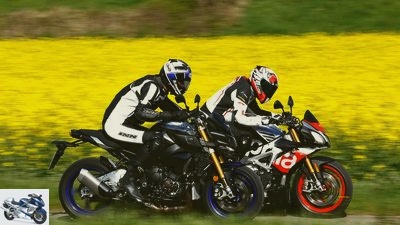
1/17
Aprilia Tuono V4 1100 Factory and Yamaha MT-10 SP are two naked bikes based on a super sports motorcycle.
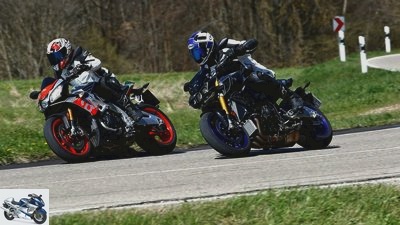
2/17
In the noble versions Factory and SP, the two motorcycles face each other to exchange blows.
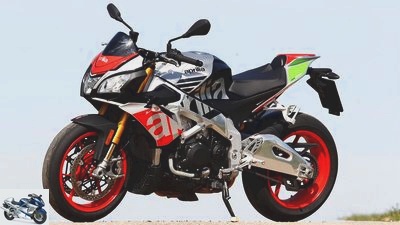
3/17
The Tuono has a V4 engine with a full 1077 cubic centimeters of displacement.
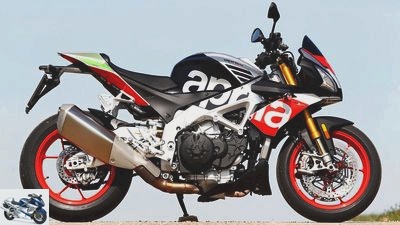
4/17
Deep in front and high in the back: the Tuono stands aggressively on its wide wheels. The exhaust has increased in volume compared to its predecessor.
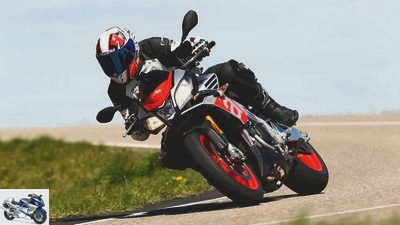
5/17
As soon as the place-name sign is behind the Tuono, the sleeping volcano becomes an energy-breathing monster.
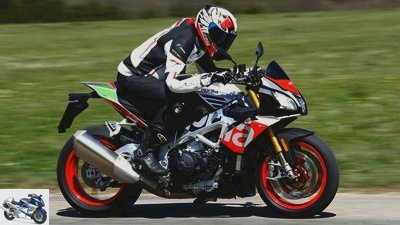
6/17
Even from low engine speeds, the Factory pushes ahead like nothing else, animating with its emotional thunder from the airbox and exhaust pipe to let the gas sit a little longer.
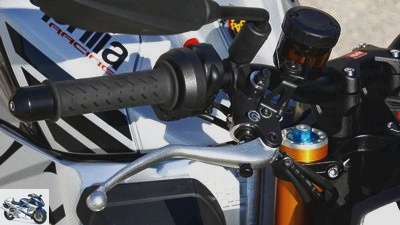
7/17
New for 2017: the Brembo radial brake pump.
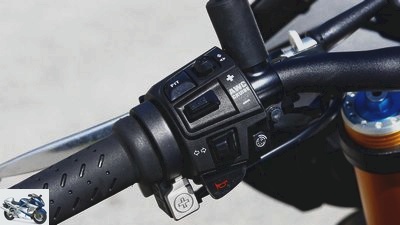
8/17
Settings center: This switch unit has the assistance systems under control.
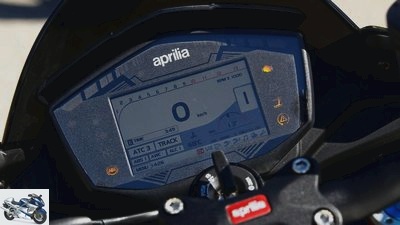
9/17
The TFT display with lots of information, including an indication of the incline.
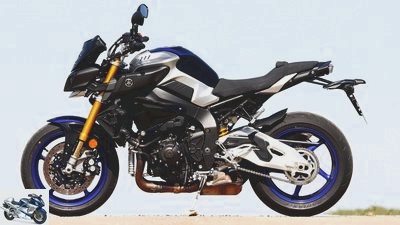
10/17
At Yamaha, in contrast to its conventional sister, the SP version has a chassis from Sweden.
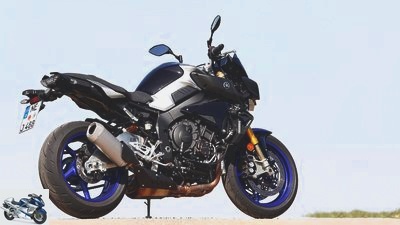
11/17
High front and rather low rear: The MT-10 is on touristic, the exhaust is small because of the front silencer.
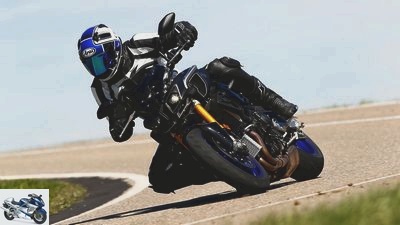
12/17
This even works semi-actively, i.e. it adjusts the damping while driving.
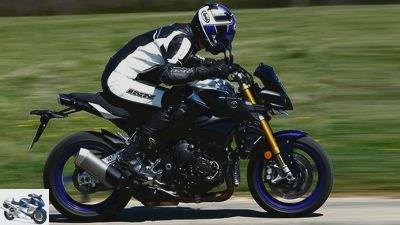
13/17
The MT-10 SP has undoubtedly one of the most beguiling four-cylinders in the naked bike sector. Your Inline-Four mimics a V4 with its crank pin offset.

14/17
Like the Aprilia, the Yamaha also has an Ohlins chassis.
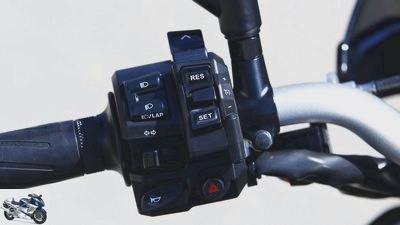
15/17
Lots of buttons on the left and a rotary knob on the right: Concentration is required.
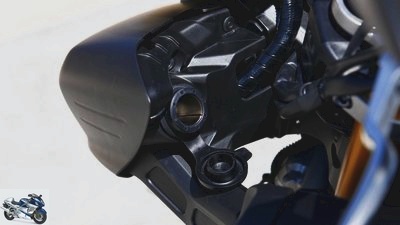
16/17
For cell phone chargers and navigation system users: 12 volt socket in the small front mask.
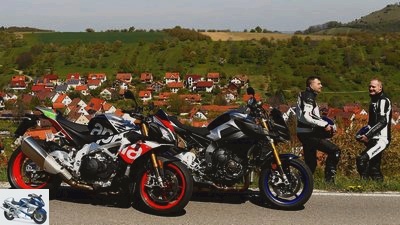
17/17
Overall, Italy beats the competition from Japan. In terms of price-performance ratio, however, the Yamaha MT-10 SP has the edge.
Aprilia Tuono V4 1100 Factory and Yamaha MT-10 SP in the comparison test
Duel of the power naked bikes
Aprilia’s Tuono V4 1100 already bears the rumble in its name, Yamaha’s MT-10 springs directly from the dark side of their homeland. In the noble versions Aprilia Tuono V4 1000 Factory and Yamaha MT-10 SP, the two naked bikes face an exchange of blows.
A.prilia demonstrated it in 2003: why not just strip the company‘s popular super sports car for fans of wide handlebars? The successful Tuono model has been part of the range ever since, except that, as with the race bike, the former V2 Rotax engine has now become a V4 heart. Since it is not relevant for the Superbike World Cup, that can be happy about 1077 cubic centimeters, is more than the liter of the sporty offshoot.
Buy complete article
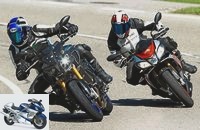
Aprilia Tuono V4 1100 Factory and Yamaha MT-10 SP in the comparison test
Duel of the power naked bikes
Yamaha comes into focus. Finally, unlike its conventional sister, the SP version also has a chassis from Sweden. It even works semi-actively, using information that is collected in the ECU to adjust the damping while driving. Another difference to the normal MT-10 is the TFT cockpit. Motor mappings, traction control, cruise control and ABS are also part of the good form with her.
Video comparing the power naked bikes:
Ignition on: The Aprilia cockpit, which can be displayed in either racing or normal mode, starts up. A short check of the on-board systems follows. The thumb presses the starter, the V4 wakes up like a dragon that has been awakened from its nap. The 65-degree V4 pulsates hard and rough even when the vehicle is stationary, and is still relatively socially acceptable in terms of volume. The corridors find each other smoothly, the country road calls. As soon as the place-name sign is behind the Factory’s Diablo Supercorsa SP, the dormant volcano below you turns into an energetic monster. Even at low engine speeds, the Factory pushes ahead like nothing else, encourages with its emotional thunder from the airbox and exhaust to let the gas sit a little longer, taunts mercilessly at every moment of the two-way relationship between driver and motorcycle, always wants to be driven, always drives. Low speeds become medium ones, become high, thrust and engine fire only come to an end beyond 11,000 rpm, and then the maximum output of 175 horsepower has already been passed.
Rolling slowly with the Tuono Factory is difficult to achieve. Which is due to the excellent chassis. If the tires are up to temperature, it delivers unshakable stability without ever becoming unwieldy. But on the contrary. The Factory bends easily, with good road holding, in every curve radius, it even masters braking in an inclined position without any set-up torque. The brakes still have to be lifted out.
Up until the last year there was some criticism for her. The combination of a normal hand pump and somewhat dull rubbers was not a good choice. Aprilia responded. The hand now reaches for the finest Brembo radial goods, the M50 pliers from the same company bite into pizza-sized slices measuring 330 millimeters. And the combination is really really good. Because it can be precisely dosed, because the ABS, adjustable in three stages, works perfectly together with the lift detection for the rear wheel. It doesn’t get any better – regardless of whether a novice or an expert pulls the lever. You just have to be clear: With the Aprilia, the focus is clearly on racing, not on traveling. Those who accept this take one of the most exciting two-wheeled planes for a walk, which captivates the heart and soul more with every meter.
And the Yamaha? Without a doubt, it also has one of the most beguiling four-cylinder cylinders in the naked bike segment. Thanks to the crank pin offset, your Inline-Four mimics a V4. And really good. In the lower speed range it growls leisurely to itself, but its character changes from around 6000 to 7000 rpm. Then the strong propulsion becomes a real rocket, with a sound that makes the hair on the back of the neck stand up. 160 hp at 11500 rpm are a word. This is underpinned by the acceleration and torque values. Although they are higher than those of the Tuono, they are in themselves worthy of all honor. As with Aprilia, the basic features of the MT-10 are based on a super sports car, the R1. Only they don’t approach the whole thing as radically as the Tuono. Emotion can also mean enjoying. Without being slow, of course.
A good example of this is the almost touristy space available. The MT-10 SP embeds the driver like in Abraham’s lap, its large seat cushion scores with comfort and convenience. The landing gear is aiming in the same direction. The two semi-active modes as well as the three manual basic settings can each be adjusted in 32 stages for the compression and rebound stage of fork and damper. High numbers mean a soft, dresser selection, lower numbers noticeably harden the chassis. Compared to the normal MT-10, this is a significant gain. This is increased by the fact that you can switch between the preset chassis modes while driving. If a bumpy road comes into your sights, simply choose a softer setting and glide casually over it, if you want to move quickly over smooth asphalt, a sporty choice is made in no time. It works fine. Whereby the Yamaha knows how to combine handiness and stability. It is therefore well equipped for all requirements from everyday life to the crisp round on Sunday morning.
With all the light, however, there are also shadows. Not with the chassis, a little with the brakes. The MT-10 SP still stops with a conventional pump, its ABS also regulates somewhat roughly, especially on bumps it tends to do a stoppie handstand. Another thing she doesn’t like is braking in corners. The MT-10 SP wants to line up spontaneously, the Bridgestone S20 in special specification “W” immediately go straight ahead.
In addition, you like Quickshifter, the gear changes are a bit rough and harsh on the stage. And the clutch should be able to be dosed finer, the pressure point comes late, the grinding point is not lush. Despite the three power modes for the engine with different responses – as with the Aprilia – load changes can be felt, especially when the gas is closed. Otherwise the drive is easy to handle and does not raise any questions. The mainstay of the Yamaha remains its chassis. The diverse setting options allow a wide balancing act between hard and soft, are a real gain in comfort. Which, however, cannot be enjoyed for long in a row because the fuel gauge asks to refill. 6.5 liters consumption on the moderate 100-kilometer lap: That’s a lot.
But I can too, thinks the Aprilia, which swallows just as much fuel over the same distance. But that is not the only shadow that comes to the fore. What worries the Tuono the most is its radicalism. It is designed for pure fast driving. Only then are the blipper’s interruption times correct, which are otherwise unusually long, then the hard tuning of your chassis, which has plenty of reserves, fits. Only when the Supercorsa are still cold and the throttle valves are not permanently open can the limits of radicalism be quickly enumerated. Bumps are more likely to be driven over than ironed out, the back and hands on the low, slightly cranked handlebars are precisely informed about every paragraph in the street scene. In addition, the seating position is very crisp for a naked bike. The distance between the bench and the rests is extremely sporty, especially long ones lack freedom of movement. And last but not least, there is the sound: of course, it tickles every fiber of the body. But the Tuono barks almost unattenuated from 5000 rpm. Then a flap in the silencer switches to free passage. What is particularly annoying about it: The pilot notices a lot of this sound fireworks, but the environment even more. The Tuono is simply too loud, even if it is just as approved.
Soon the heart leaf door will open, who can it be: Thunderbird or dark Japanese? If the motorcyclist’s life could be represented on a 100 percent scale, where everyday life and utility are at the bottom, top sportiness at the top, the factory fulfills everything between 40 and 100 percent. Despite more civilized manners than its predecessor, such as the clearly gentler response in all engine mappings: Your world is called full throttle. She can do this beguilingly, almost incomparably well. The Yamaha would be the slower bike if it really matters. But for that it would have to be really going on on the track. Its engine turns on, but it doesn’t bump its modern nose against such mundane demands as everyday life, it would be a zero to 95 percent two-wheeler. And if a decision-making aid is required: The Tuono as a factory costs a whopping 18,490 euros, the MT-10 SP is 1700 euros cheaper at 16,790 euros. There is definitely thunder and darkness for the bank account, regardless of the choice.
MOTORCYCLE test result
1. Aprilia Tuono V4 1100 Factory
Italy beats Japan. The weaknesses of the predecessor such as the bad brakes have been ironed out, the character has been further sharpened, and it is clearly called racing, with no ifs or buts.
2. Yamaha MT-10 SP
The semi-active landing gear of the SP is an advantage over the normal MT-10. Otherwise, the naked does well, but too few points in terms of payload, ABS and brakes cost victory.
Related articles
-
Comparison test Aprilia Tuono V4 1100 Factory, BMW S 1000 R, KTM 1290 Super Duke R, Yamaha MT-10 SP
factstudio.de 38 pictures fact 1/38 Aprilia Tuono V4 1100 Factory, BMW S 1000 R, KTM 1290 Super Duke R and Yamaha MT-10 SP in comparison. fact 2/38 Aprilia …
-
Comparison test of 125cc naked bikes – Aprilia Tuono 125, Yamaha MT-125 and KTM 125 Duke
18 pictures 1/18 Away with the smartphone, boys and girls. Forget Twit-Snap and Insta-Chat, because real life takes place outside …
-
Aprilia Tuono V4 1100 RR in the top test
Rivas 45 pictures Rivas 1/45 Aprilia Tuono V4 1100 RR. Rivas 2/45 Aprilia Tuono V4 1100 RR. Rivas 3/45 Aprilia Tuono V4 1100 RR. Rivas 4/45 Aprilia Tuono …
-
Aprilia Tuono V4 1100 Factory and Yamaha MT-10 in comparison test
Bilski 21st photos www.bilski-fotografie.de 1/21 Nordschleife comparison with the Aprilia Tuono V4 1100 Factory and Yamaha MT-10….
-
Comparison test Ducati Monster 900 i.e, Moto Guzzi V11 Sport Scura, Yamaha BT 1100 Bulldog
Gargolov comparison test Ducati Monster 900 i.e, Moto Guzzi V11 Sport Scura, Yamaha BT 1100 Bulldog Tingling in the stomach Three very different twins with …
-
Yamaha FZ1 and Yamaha MT-10 in comparison test
www.bilski-fotografie.de 21 images www.bilski-fotografie.de 1/21 There comes joy. Dynamic country road burners with great chassis …
-
Aprilia Tuono V4 1100 RR and Aprilia RSV4 RR in comparison test
fact 14 pictures fact 1/14 Even if tastes are known to be different: With these two bikes it doesn’t matter … fact 2/14 The Aprilia got …
-
Comparison test Aprilia Tuono V4 1100 Factory KTM 1290 Super Duke R 2018
Arturo Rivas 16 pictures Rossen Gargolov 1/16 Anyone who has been able to enjoy this power and magnificence will never forget it. Rossen Gargolov 2/16 …
-
Comparison test: Aprilia, BMW, Husqvarna, KTM and Yamaha
fact comparison test: Aprilia, BMW, Husqvarna, KTM and Yamaha single-cylinder fun bikes They have a big heart, a very big one. The new…
-
Aprilia Tuono V4 1100 RR, Kawasaki Ninja H2 and BMW S 1000 XR in the comparison test
Arturo Rivas Gonzalez 31 pictures Arturo Rivas Gonzalez 1/31 Aprilia Tuono V4 1100 RR, Kawasaki Ninja H2 and BMW S 1000 XR. Arturo Rivas Gonzalez 2/31 And …